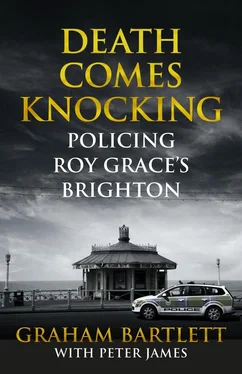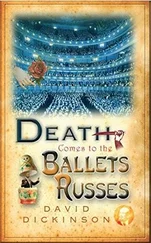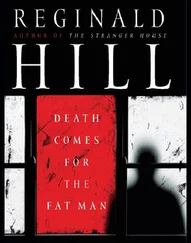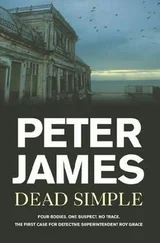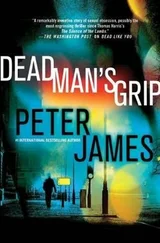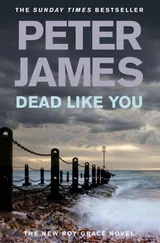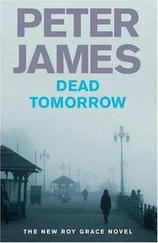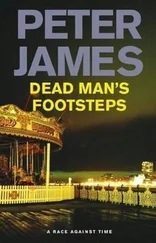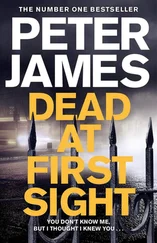Our very good friend Chief Superintendent Nev Kemp, Brighton and Hove’s Divisional Commander, has been enormously helpful as has Detective Inspector Bill Warner, who was only too happy for his crazy ways to be laid bare for all to read. DS Julian Deans and PC Darren Balkham, who in their own very different ways make Brighton and Hove so much safer, have provided a rare insight into their unique worlds. Inspector Matt Webb and PC Mark White of the Police Federation have provided fabulous support in researching people and events gone by.
The courage of the victims of crime who helped cannot be underestimated. To ask them to relive traumatic events seemed an intrusion but Dr Alison Hewitt, Glynn Morgan and Fiona Perry were so incredibly helpful and we will be forever in their debt.
On the other side of the law, for some ex-offenders to happily talk to us about their exploits and the consequences of their crimes was as welcome as it was surprising. David Henty, Clifford Wake and Paul Teed were only too happy to provide a perspective that, otherwise, would have been sorely missed.
Like cops, journalists have enduring memories and see the world from a slightly different angle to that of the police and crime writers. The help of Phil Mills, Emily Walker, Michael Beard and Mike Gilson, all either currently at or previously of Brighton’s Argus newspaper, is hugely appreciated in not only contributing to the stories but also in sourcing some of the photographs from their dusty archives.
Special thanks go to our wonderful agent Carole Blake of Blake Friedman Literary Agency, who always goes the extra mile, and to the incredibly patient and inspirational Ingrid Connell, who provided such magnificent guidance throughout the writing. Much gratitude too is owed to our editor Susan Opie, whose patience and eye for detail are something to behold. Geoff Duffield, of Pan Macmillan, deserves a particular mention as it was he who, when presented with the embryonic plan for this book, gave such fulsome encouragement and support, something he has sustained throughout. Others who have provided excellent critical reflections on various stages of the manuscript include Linda Buckley and Phil Viner.
The fabulous and energetic staff at Midas PR, especially Tony Mulliken, Sophie Ransom and Becky Short, have been brilliant in so fully and enthusiastically promoting this book,
Mostly though, for not only providing constant physical and emotional support and encouragement but also for reading and re-reading draft after draft, huge love and thanks go to our wives Julie and Lara. Julie has been with Graham on the rollercoaster of self-doubt and elation every step of the way. To adapt from a wife whose husband was mainly at work trying to cure the ills of a city he loves, to having him under her feet pulling his hair out over rhythm, syntax and grammar is no mean feat. Thank you both so much as we literally couldn’t do this without you.
Graham Bartlett and Peter James
ANPR— Automatic Number Plate Recognition. Roadside or mobile cameras which automatically capture the registration number of all cars that pass. It can be used to historically track which cars went past a certain camera and can also trigger alerts for cars which are stolen, have no insurance or have an alert attached to them.
ARV— Armed Response Vehicle.
CCTV— Closed Circuit Television. Can be either publicly owned and monitored (e.g. by the police), or privately installed in people’s houses or businesses.
Chief Officer— A police officer of or above the rank of Assistant Chief Constable (in most forces) or Commander (in the Metropolitan or City of London Police).
CID— Criminal Investigation Department. Usually refers to the divisional detectives rather than the specialist squads.
Commanders
Gold (or strategic) Commander — The Gold commander sets the strategy and assumes and retains overall strategic command for the operation or incident.
Silver (or tactical) Commander — The Silver commander commands and coordinates the overall tactical response in compliance with Gold’s strategy, and is the tactical commander of the incident.
Bronze (or operational) Commander — The Bronze commander is responsible for the command of a group of resources, and carries out functional or geographical responsibilities to deliver the requirements set by Silver in their tactical plan.
CPS— Crown Prosecution Service. The public agency that conducts criminal prosecutions in England and Wales.
CSI— was SOCO — Crime Scene Investigators (Scenes of Crime Officers). They are the people who attend crime scenes to search for fingerprints, DNA samples etc.
DNA— Deoxyribonucleic Acid. A molecule that encodes the genetic instructions used in the development and functioning of all known living organisms and many viruses. Used in policing to identify the source of bodily samples left at crime scenes. Generally provides a 1:1 billion certainty of the source/person.
DVLA— Driver and Vehicle Licensing Authority. The Government agency that registers motor vehicles and issues driving licences. An important source of intelligence in many enquiries.
Golf 99— The call sign for the divisional duty inspector who is expected to take ground command of critical incidents, working usually alongside Ops-1 or to the CIM.
HOLMES— Home Office Large Major Enquiry System. The national computer database used on all murders. It provides a repository of all messages, actions, decisions and statements, allowing the analysis of intelligence and the tracking and auditing of the whole enquiry. Can enable enquiries to be linked across force areas where necessary.
Intel Cell— Intelligence cell. A dedicated team of officers and staff who provide the intelligence research and analysis to a major crime or incident.
IPCC— Independent Police Complaints Commission. Body that oversees the police complaints system in England and Wales and sets the standards by which the police should handle complaints. Will determine, in certain cases, whether the investigation should be handled locally, managed/supervised by themselves or independently investigated.
LST— Local Support Team. The standing unit of officers who provide public order, search and low-level surveillance tactics on a division. Can be drawn together to form a PSU (see below).
MIR-1— Major Incident Room 1. One of the large rooms in the Major Incident Suite where most of the investigation team work and brief.
Misper— Short for ‘missing person’.
MO— Modus Operandi (method of operation). The manner by which the offender has committed the offence. Often this can reveal unique features which allow crimes to be linked or suspects to be identified.
Ops-1— The call sign of the Force Control Duty Inspector, who has oversight and command of all critical incidents in the initial stages.
PCSO— Police Community Support Officer. These are uniformed neighbourhood officers who work in communities but do not have police powers such as arrest, search, use of force etc.
POLSA— Police Search Advisor. A trained and accredited officer who provides advice on where to search for something or someone, and how in any given circumstance. Can be used as the Bronze commander (see above) for the search elements of an enquiry or incident.
Читать дальше
